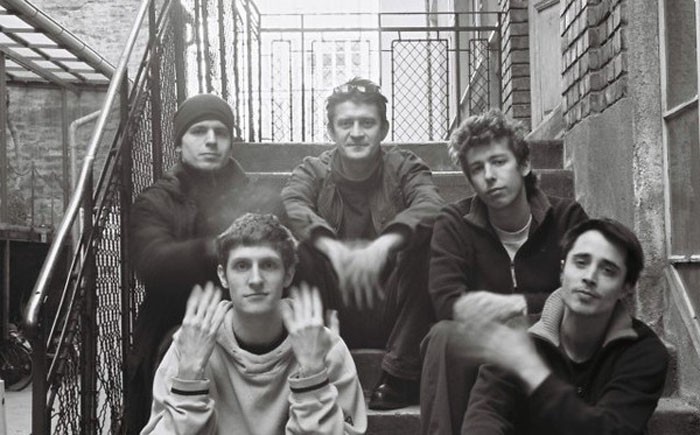
Due to its impetuous lyrical and poetic energy, Nifty’s had to be experienced live as one did in Alhamra last week

As was evident from the music performance of the group Nifty’s at the Alhamra last week, the major thrust of musical expression has shifted to mixing the genre and forms in contemporary times.
On their recent visit to Pakistan, Nifty’s performed with two well-known local musicians Ustad Bashir Khan on the tabla and Ustad Nafees Khan on the sitar. This partnership took shape when they got together about a couple of years back and started to work on their experimental stuff, wanting to explore music beyond the boundaries of the respective genres and forms. Apparently, they had been working together and performed on a number of occasions abroad as well.
According to the brochure, the group from the Alps calls itself surf blues freak out klezmer. Old time klezmer is the starting point for the band. Two guitars duel each other on top of a super solid and highly energetic driving bass and drums foundation. Pollack and Michael Bruckner on the guitars, Dominik Grunbuhel on the bass and Valentin Duit on the drums have taken it away from its essence, for Nifty’s takes pride in the fact that it cannot be nailed down to any one specific genre.
After its first album ‘Takeshi Express’ which was committed to new klezmer, it decided not to limit itself to any single genre; instead, it continued with its reinterpretation of traditional klezmer. With its second album ‘Naftularasa’, it opted for a bold combination of a wide range of sounds from klezmer to metal to polka to surf rock. In its third album NO3, this four man combo has kept pursuing its open and experimental path.
Compared with most other European folk music styles, little is known about the history of klezmer music, and much of what is said about it must be seen as conjecture. Originally, klezmer referred to musical instruments and was later extended. It was not till the late twentieth century that the word came to identify a musical genre.
What one gathered from a conversation with the group, klezmer music originated in the Ukraine and was basically dance music to which people sang and danced on important occasions. It was also played at wedding ceremonies. The traditional klezmer tunes that were played by Nifty’s and also those in the recordings that its members had had brought along was more like the dance music that one associated with the Russian folk music and melodies some of which finds adequate expression in classical composed pieces like Tchaikovsky’s ‘Nutcracker’.
This could have been the first formal concert of klezmer music in the country. It said that klezmer is a musical tradition of Eastern Europe. Played by professional musicians called klezmorim, according to Wikipedia, the genre in the United States evolved considerably as Yiddish speaking Jewish immigrants from Eastern Europe, who arrived between 1880 and 1920, met and assimilated American jazz.
Klezmer instrument choices were traditionally based, by necessity, on an instrument’s portability. Instruments held in the hands -- clarinet, violin, trumpet, flute or supported by a neck or shoulder strap accordion, cimbalom, drum -- were favoured over those that rested on the ground like cello, bass violin, or needed several people to move piano. In America, this trend has continued into the present day, with hand-held or strap-held instruments like guitars, saxophones, and even harmonicas integrated into klezmer ensembles. The typical American klezmer wedding band uses a portable electronic synthesiser, not a piano.
It appears that though klezmer music had its origins in the liturgical tradition of the synagogue, it outgrew that and has taken forms that have secular trappings now. It is fully integrated into the mainstream to be experimented with hugely as there appeared to be a great influence of jazz in the concert. And that too European jazz, for it does not carry the feel of the American jazz but is more a foreground for experimentation, improvisation and innovation as the structure is not as rigid as of the European classical music.
Our musicians were more at home in the traditional klezmer which was familiar with its dance tune and rhythmic pattern, and were a little lost with the experiment going over the edge.
These days there is great stress on discovering the commonality of musical expression, especially between very diverse forms, but there was more of it when the more traditional klezmer was played rather than its extreme example of experimentation. Yet due to its impetuous lyrical and poetic energy, Nifty’s had to be experienced live.
Austria is home to high western classical tradition and Vienna is the capital of music in the world and one expects classical musicians with their repertoire to perform outside their continent or the western world and travel to lesser developed regions of the world. One issue of serious intent could be the finances because these musicians must be frightfully expensive to engage for foreign tours. But that is exactly the reason why they should perform in countries like Pakistan. They would not be affordable otherwise.
Embassies could be the only conduit for the realisation of such possibilities and for the people to be with the top line musicians in their midst.